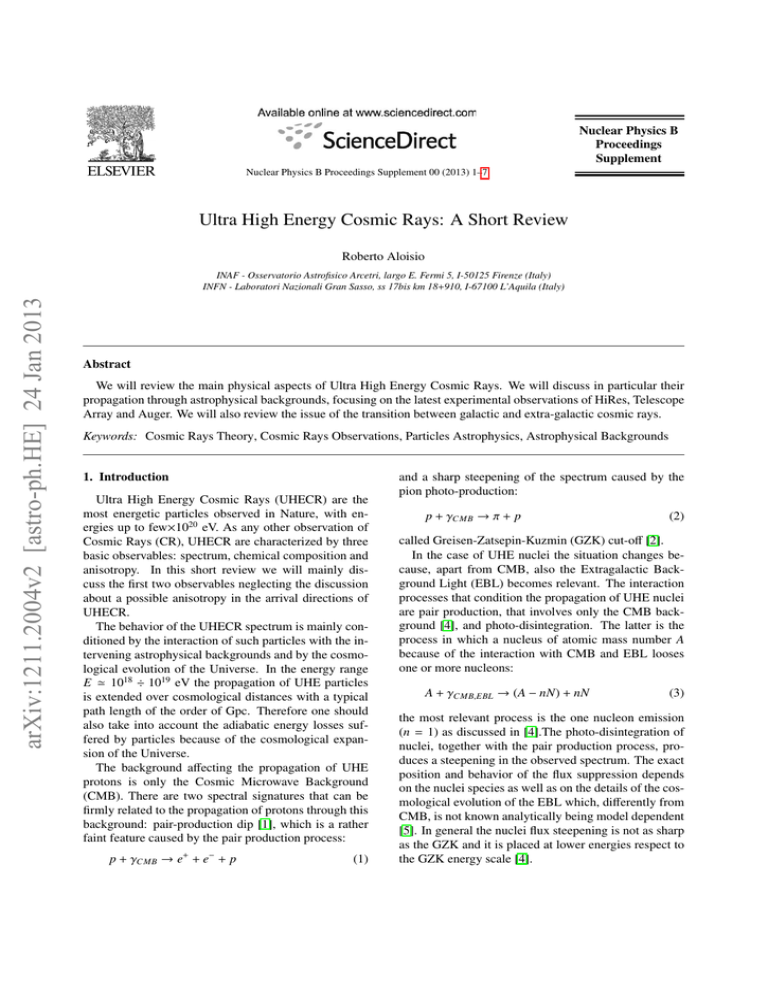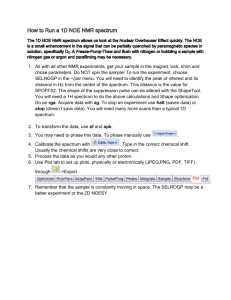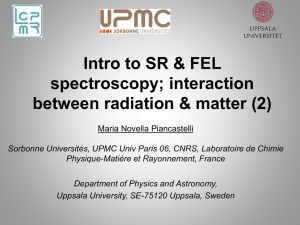Ultra High Energy Cosmic Rays: A Short Review Nuclear Physics B Proceedings Supplement
advertisement

Nuclear Physics B
Proceedings
Supplement
Nuclear Physics B Proceedings Supplement 00 (2013) 1–7
Ultra High Energy Cosmic Rays: A Short Review
Roberto Aloisio
arXiv:1211.2004v2 [astro-ph.HE] 24 Jan 2013
INAF - Osservatorio Astrofisico Arcetri, largo E. Fermi 5, I-50125 Firenze (Italy)
INFN - Laboratori Nazionali Gran Sasso, ss 17bis km 18+910, I-67100 L’Aquila (Italy)
Abstract
We will review the main physical aspects of Ultra High Energy Cosmic Rays. We will discuss in particular their
propagation through astrophysical backgrounds, focusing on the latest experimental observations of HiRes, Telescope
Array and Auger. We will also review the issue of the transition between galactic and extra-galactic cosmic rays.
Keywords: Cosmic Rays Theory, Cosmic Rays Observations, Particles Astrophysics, Astrophysical Backgrounds
1. Introduction
Ultra High Energy Cosmic Rays (UHECR) are the
most energetic particles observed in Nature, with energies up to few×1020 eV. As any other observation of
Cosmic Rays (CR), UHECR are characterized by three
basic observables: spectrum, chemical composition and
anisotropy. In this short review we will mainly discuss the first two observables neglecting the discussion
about a possible anisotropy in the arrival directions of
UHECR.
The behavior of the UHECR spectrum is mainly conditioned by the interaction of such particles with the intervening astrophysical backgrounds and by the cosmological evolution of the Universe. In the energy range
E ' 1018 ÷ 1019 eV the propagation of UHE particles
is extended over cosmological distances with a typical
path length of the order of Gpc. Therefore one should
also take into account the adiabatic energy losses suffered by particles because of the cosmological expansion of the Universe.
The background affecting the propagation of UHE
protons is only the Cosmic Microwave Background
(CMB). There are two spectral signatures that can be
firmly related to the propagation of protons through this
background: pair-production dip [1], which is a rather
faint feature caused by the pair production process:
p + γCMB → e+ + e− + p
(1)
and a sharp steepening of the spectrum caused by the
pion photo-production:
p + γCMB → π + p
(2)
called Greisen-Zatsepin-Kuzmin (GZK) cut-off [2].
In the case of UHE nuclei the situation changes because, apart from CMB, also the Extragalactic Background Light (EBL) becomes relevant. The interaction
processes that condition the propagation of UHE nuclei
are pair production, that involves only the CMB background [4], and photo-disintegration. The latter is the
process in which a nucleus of atomic mass number A
because of the interaction with CMB and EBL looses
one or more nucleons:
A + γCMB,EBL → (A − nN) + nN
(3)
the most relevant process is the one nucleon emission
(n = 1) as discussed in [4].The photo-disintegration of
nuclei, together with the pair production process, produces a steepening in the observed spectrum. The exact
position and behavior of the flux suppression depends
on the nuclei species as well as on the details of the cosmological evolution of the EBL which, differently from
CMB, is not known analytically being model dependent
[5]. In general the nuclei flux steepening is not as sharp
as the GZK and it is placed at lower energies respect to
the GZK energy scale [4].
R. Aloisio / Nuclear Physics B Proceedings Supplement 00 (2013) 1–7
2. HiRes and TA data: dip and GZK cut-off
The dip is a quite faint feature that arises in the spectrum of UHE protons in the energy range 2 × 1018 eV
1
-
e+ e
10-1
η(E)
The GZK cutoff is the most spectacular feature in
the UHECR spectrum. However one must remember
that it is defined only for UHE protons interacting with
the CMB filed. The cutoff energy position is roughly
fixed by the energy where the pair-production (Eq. (1))
and the photo-pion production (Eq. (2)) energy losses
become equal, namely at EGZK ' 50 EeV [3]. The
shape of the GZK flux suppression could also be modeldepend: it depends on a possible local over-density or
deficit of sources and can be mimicked by low enough
values of the maximum energy that sources can provide.
In contrast, the pair-production dip is practically modelindependent mainly because protons contributing to this
energy range arrive from sources lying at cosmological
distances.
From the experimental point of view the situation is
far from being clear with different experiments claiming contradictory results. The HiRes and, nowadays,
the Telescope Array (TA) experiments show a proton
dominated composition till the highest energies with a
clear observation of the proton pair-production dip and
GZK cut-off [6]. Chemical composition observed by
HiRes and TA is coherent with such picture showing a
pure proton dominated spectrum starting from energies
E ' 1018 eV till the highest energies. The experimental picture changes taking into account the Auger observations. The spectrum observed by Auger shows a
behavior not clearly understood in terms of the proton
pair-production dip and GZK cut-off [7]. This spectral
behavior could be a signal of a substantial nuclei pollution in the spectrum, which is confirmed by the Auger
observations on chemical composition that show a progressively heavy composition toward the highest energies, this tendency starts already at E & 4 × 1018 eV
[7]. In this short review we will discuss the main issues
in the physics of UHECR presenting a twofold discussion from both experimental as well as theoretical point
of view. The paper is organized as follows: in section
2 we will mainly discuss the two observable features
connected with protons propagation, i.e. dip and GZK
cut-off, presenting a comparison with HiRes and TA
data, in section 3 we will focus on the Auger observations of spectrum and chemical composition, discussing
the consequences of a nuclei dominated spectrum, in
section 4 we will discuss the physics of the transition
between galactic and extra-galactic CR, finally conclusions will take place in section 5.
2
10-2
γ g = 2.1 - 3.0
10-3
1018
1019
1020
E, eV
total
1021
1022
Figure 1: Modification factor for different values of γg (see text).
÷5 × 1019 eV due to the pair production process; it
is a unique imprint of the interaction of protons with
the CMB background. The dip behavior is more pronounced when analyzed in terms of the modification
factor η(E) = J p (E)/ jumm
p (E) [1], defined as the ratio
of proton spectrum divided by the so-called unmodified
spectrum, where only adiabatic energy losses (expansion of the Universe) are taken into account.
In this paper we will always assume a power law in−γ
jection spectrum for UHECR, namely Q(Eg ) ∝ Eg g
being Eg the UHECR generation energy eventually
bounded from above by the maximum attainable energy
at the source Egmax . A useful characteristic of the modification factor is its universality, it depends very weekly
on the injection power law index and on various physical phenomena that can be included in the calculation
[1]. In figure 1 we plot η(E) for different values of γg
(as labelled); it can be seen that if one includes in the
calculation of J p only adiabatic energy losses then, by
definition, η(E) = 1 (dash dotted line). When e+ e− production is additionally included one obtains η(E) as labelled in figure 1, this behavior corresponds to the pairproduction dip. Finally, if all channels of energy losses
are taken into account η(E) shows also the GZK suppression, curve labelled ’total’. The only ”critical” assumption at the very base of the dip behavior is the proton dominated spectrum, already a nuclei pollution at
the level of 15% will spoil the behavior of figure 1.
Modification factor is a very useful tool to study the
effect of the CMB radiation field on the propagation of
UHE protons and can be compared with observations
simply dividing the observed spectra by the unmodified
spectrum J umm
(E) ∝ E −γg . In figures 2,3 we compare
p
the modification factor with the observations of HiRes
and TA [6]. This comparison involves only two free
R. Aloisio / Nuclear Physics B Proceedings Supplement 00 (2013) 1–7
0
1
modification factor
modification factor
10
ηee
10
-1
HiRes I - HiRes II
10
ηee
10-1
TA MD
TA SD
-2
17
10
10-2
ηtotal
γg=2.7
10
3
η
total
γ =2.6
g
18
10
19
10
20
10
21
E, eV
Figure 2: The pair production dip compared with the HiRes experimental data [6], this experiment confirms the pair-production dip with
good accuracy (χ2 /d.o. f. ' 1.0 ÷ 1.2).
parameters: the power law index at injection γg and the
total emissivity of UHE protons sources.
The fit of HiRes and TA data to the pair-production
dip is quite good with a χ2 /d.o. f ' 1 and a best fit value
of γg ' 2.7 for HiRes and γg = 2.6 for TA. From figures
2,3 one can notice that the modification factor observed
by HiRes exceeds the theoretical one around EeV energies; since by definition η(E) 6 1 this excess signals the
appearance of a new component of CR at E < 1 EeV.
This component can be nothing else but the galactic cosmic rays. Therefore the dip model for UHECR implies
a transition from galactic to extra-galactic CR at E . 1
EeV, we will come back to this in section 4.
The experimental observations of HiRes and TA
show a strong evidence of the GZK cut-off in the spectra, while Auger data, that we will discuss in the next
session, seem less compatible with the expected GZK
behavior of the spectra. In general all experiments show
a flux suppression at the highest energies, nevertheless
to ascribe it to the process of photo-pion production of
protons on the CMB field (i.e. GZK suppression) one
must prove that: (i) the energy scale of the cut-off and its
shape correspond to the theoretical predictions, (ii) the
observed chemical composition is strongly dominated
by protons.
The integral spectrum of protons J p (> E) has a power
law behavior at low energy. Increasing the energy, because of the photo-pion production process, J p (> E)
shows an abrupt suppression (i.e. GZK cut-off). The energy scale at which this suppression arises can be evaluated as the energy at which the integral flux is reduced
by half of its low energy value. This energy scale E1/2
18
10
19
10
20
10
1021
E, eV
Figure 3: The pair production dip compared with the TA experimental
data [6].
can be computed with extreme accuracy and it is found
to be practically model independent [3], its theoretical
prediction is E1/2 = 1019.72 eV ' 52.5 EeV [3].
The HiRes and TA observations show a proton dominated spectrum at all energies E > 1018 eV [6], moreover the HiRes collaboration measured E1/2 obtaining a
value in a pretty good agreement with theoretical expecHiRes
tations, namely E1/2
= 1019.73±0.07 eV. These experimental evidences show a coherent picture of a proton
dominated flux that exhibits the expected features: pairproduction dip and photo-pion production suppression
(GZK).
3. Auger data: heavy nuclei
The spectrum observed by the Pierre Auger experiment, shown by filled squares in figure 4, differs from
the HiRes and TA spectra, shown by triangles and circles. On the other hand, as discussed in the previous
section, the HiRes/TA data are well fitted by the pairproduction dip, shown as continuos line in figure 4.
In the framework of the dip model, taking into account the systematic errors in energy determination, one
can try to shift the Auger energy scale having the dip behavior as reference. This procedure, proposed in [1], is
based on the fact that the energy position of the pairproduction dip is rigidly fixed by the interaction of protons with the CMB radiation field, so that it can be used
as a ”standard candle”. This approach is based on a single hypothesis: a pure proton composition of UHECR.
Shifting accordingly to the dip ”standard candle” the
energy scale of the Auger data one has the result shown
in figure 5. Where the Auger data have been shifted
E J(E), eV2m-2s-1sr -1
1024
HR 1
HR 2
1023
TA SD
PAO
HR 1
HR 2
TA MD
1023
TA SD
PAO with 22% energy upscale
γ g = 2.5, Emax= 1022 eV, zmax=4, m=3
γ g = 2.5, Emax= 1022 eV, zmax=4, m=3
1019
4
1024
3
TA MD
3
E J(E), eV2m-2s-1sr -1
R. Aloisio / Nuclear Physics B Proceedings Supplement 00 (2013) 1–7
1020
E, eV
Figure 4: Spectrum of UHECR as observed by HiRes, TA and Auger
experiments (as labeled). Continuos line is the best fit of HiRes/TA
with a pure proton composition (dip model)
according to E → kcal E with kcal = 1.22, allowed by
the systematic error claimed by the Auger collaboration
[7].
After the energy shift, the apparent coincidence of the
Auger and HiRes/TA data is mainly related to the low
energy part of the spectra (see figure 5), while at the
highest energies statistical uncertainties are too large to
distinguish among spectra. Nevertheless, while HiRes
and TA data are compatible with the GZK steepening
the Auger data, which at energies around 50 EeV still
show low statistical errors, are not compatible with the
behavior expected from the photo-pion production process of protons on the CMB field.
Even playing with the different parameters involved
in the computation (i.e. injection power law index γg ,
sources cosmological evolution, maximum acceleration
energy, local over-density of sources, etc.) one could
not reconcile the Auger spectrum behavior with the
GZK expectation. Being the GZK steepening a clear
signal of a proton dominated spectrum, the Auger spectrum is coherent with the chemical composition measured by this experiment at the highest energies which
is quite incompatible with a pure proton composition.
Auger data on chemical composition show a steady behavior that, starting already from energies around 3 EeV,
moves from a light (proton) to an heavier composition
reaching an almost pure Iron composition at energies
around 30 EeV [7]. These observations based on the
Auger Fluorescence Detector (FD) are further straightened by the observations of the Auger Surface Detector
(SD), namely the shower muon content and the signal
rise time in the Cherenkov tanks [8].
The early steepening observed in the Auger spec-
1019
1020
E, eV
Figure 5: The same as in 4 with the Auger spectrum shifted in energy
as E → kcal E with kcal = 1.22.
trum can be easily explained in terms of nuclei propagation. Nevertheless, even assuming a rich chemical
composition with different nuclei species injected at the
source it is not easy to obtain a good explanation of
both spectrum and chemical composition observed by
Auger. A wide class of mixed composition models [9],
while showing a good description of the spectrum, fail
to fit the mass composition observed by Auger. Most
of these models assume a mass composition similar to
the one observed at galactic scales, therefore enhanced
in protons, and the resulting mass composition starts to
become heavier only at energies E > 50 EeV [9] where
photo-pion production substantially depletes the proton
component.
At the galactic energy scales, the mass composition
becoming heavier with increasing energy appears as a
natural consequence of the rigidity dependent scenario
for particles acceleration. The maximum acceleration
energy that a single specie can reach is proportional to
p
Z
the particles charge Emax
= ZEmax
and the contribution
to the spectrum at these energies of particles with charge
lower than Z is suppressed. The disappointing model for
UHECR [13] was build exactly under such assumption
on maximum energy. In [13] was demonstrated that to
avoid a proton dominated spectrum at the highest energies one must assume that the maximum energy for
protons is in the range 4 ÷ 10 EeV. This conclusion remains valid for a large range of generation power law indexes γg ' 2.0 ÷ 2.8, nevertheless to achieve a good description of the observed UHECR spectrum in the disappointing model one should assume a quite flat injection
spectrum with γg = 2.0 ÷ 2.2. This fact, as we will discuss in the next session, has important consequences on
the transition between galactic and extra-galactic CR. In
R. Aloisio / Nuclear Physics B Proceedings Supplement 00 (2013) 1–7
E
=2.0
g
=2.0
-1
1024
-2
Fe
p
Fe
3
3
2
p
2
= 4 EeV;
max
-1
-1
g
1024
-2
-1
E J(E), eV m sec ster
= 4 EeV;
max
E J(E), eV m sec ster
E
5
1023
1018
1019
1020
E, eV
Figure 6: Energy spectrum in the two components model with proton
and iron nuclei for a homogeneous distribution of sources with γg =
p
2.0 and Emax = 4 EeV.
figures 6,7 we plot two different implementations of the
disappointing model: a simple two component model
with protons and iron (figure 6), the same two components model with a diffusion cut-off in the iron spectrum
due to the possible presence of a nG scale intergalactic
magnetic field (figure 7). Note that the gap in the spectrum in figure 7 can be filled by the presence of secondary nuclei produced by the photo-disintegration of
iron.
This model was called ”disappointing” because it corresponds to a lack of many signatures predicted in the
alternative case of a proton dominated scenario, such
as the cosmogenic neutrino production and correlation
with astrophysical sources. The disappointing model
as presented here and in [13] is not complete because,
while it reaches a good description of the observed
Auger spectrum, it does not try to describe also the
chemical composition observed at all energies.
The only successful theoretical attempt to fit at once
spectrum and chemical composition of Auger was presented in [14] where it is assumed the presence of a very
nearby source (' 70 Mpc) with a very flat generation
spectrum (γg ' 1.6) injecting heavy nuclei only.
4. Galactic and extra-galactic cosmic rays
The different models aiming to describe UHECR observations have different consequences when applied to
the transition from galactic to extra-galactic CR, therefore this theme of investigation has obtained an increasing interest in recent years. In general the physics of
galactic CR is well understood in the framework of the
standard model, which is based on the paradigm of Super Nova Remnant (SNR) as sources of galactic CR and
Diffusive Shock Acceleration (DSA) as the mechanism
1023
1018
1019
1020
E, eV
Figure 7: As in figure 6 with a diffusion cut-off, the gap is expected to
be filled by intermediate mass nuclei.
of particles acceleration. In the standard model of galactic CR the observation of the knee at energy 2 × 1015 eV
in the spectrum fixes the maximum energy of protons
at the source and therefore, in a rigidity dependent scenario, the maximum energy for iron nuclei, the end of
galactic CR, will be around energies 1017 eV.
In figures 8,9 we plot together the fluxes of galactic and extra-galactic CR assuming the two different
models dip (figure 8) and disappointing (figure 9) for
UHECR and using the flux of galactic CR as computed
in [10], that takes into account the scale distribution of
SNR in the galaxy. The experimental data of figures 8,9
are those of HiRes [6] and Auger [7] on the UHECR
side and, on the galactic side, the data of all particles
spectrum of Kascade [11] and an average of the fluxes
measured by different experiments as presented in [12].
The matching of galactic and extragalactic fluxes in
the case of the dip model (figure 8) gives a very good description of the experimental data, reproducing in an extremely accurate way the spectra observations in the intermediate energetic regime where the transition is supposed to stand. The case of the disappointing model
gives a less accurate description of the experimental
data (figure 9) with a slightly suppression of the theoretical flux in the transition region not seen experimentally. The less good agreement with experimental data
obtained, in the transition region, with the disappointing
model respect to the dip model is a direct consequence
of two important facts: (i) the quite flat power law injection index (γg = 2.0) of the disappointing model, (ii)
the quite low maximum energy associated to iron nuFe
clei (Emax
' 1017 eV) in the standard model of galactic
CR. These two facts produce a lacking of particles in the
transition region not seen experimentally, to avoid such
circumstance one should assume a larger maximum energy for galactic iron. Only in this way in-fact it is pos-
104
E2.5 J(E) (m-2 s-1 sr-1 GeV1.5)
E2.5 J(E) (m-2 s-1 sr-1 GeV1.5)
R. Aloisio / Nuclear Physics B Proceedings Supplement 00 (2013) 1–7
Average gal.
HiRes-MIA
Kascade
Auger
103
102
101
100
10-1 5
10
106
107
108
109
1010
1011
1012
E (GeV)
Figure 8: Transition from galactic to extra-galactic CR in the case of
the dip model, with Emax = 1021 eV and γg = 2.7. Galactic CR flux
is taken from [10], experimental data are from HiRes [6], Auger [7],
Kascade [11] and the average over different experimental results as in
[12].
sible to fill the gap in the transition region making the
theoretical spectrum compatible with observations.
Let us conclude this section emphasizing the importance of the study of the transition between galactic and
extra-galactic CR. In general, the transition is the superposition of the low energy tail of UHECR with the high
energy tail of galactic CR and it is supposed to stand
in the energy range 0.1 ÷ 10 EeV. As discussed above
the informations obtained at these energies on galactic
CR involve the maximum acceleration energy of particles and their chemical composition. Therefore, assuming the standard model of galactic CR, the study of the
transition can unveil the whole picture of the origin of
galactic CR. Moreover, the low energy tail of UHECR
can give key informations on the (possible) existence
of the pair-production dip and on the propagation of
UHECR in intergalactic magnetic fields [15]. Therefore, the experimental studies in the transition region are
of paramount importance in this field of research, with
the mass composition measurements being probably the
most important task [15].
5. Discussion and conclusions
We face nowadays the most serious disagreement in
the observations of UHECR between the data of Auger
and HiRes/TA. While Auger points toward an heavy
composition at the highest energies, HiRes/TA shows
a proton dominated composition at all energies.
The most self-consistent conclusions on the nature of
UHECR are obtained at present by HiRes/TA: they observe a proton dominated chemical composition with a
spectrum that shows both expected signatures of protons, i.e. the pair-production dip and the GZK cut-off.
6
104
Average gal.
HiRes-MIA
Kascade
Auger
103
102
101
100
10-1 5
10
106
107
108
109
1010
1011
1012
E (GeV)
Figure 9: Transition from galactic to extra-galactic CR in the case of
the disappointing model assuming a mixture of protons, He and Fe
p
nuclei at the source with Emax = 4 × 1018 eV and γg = 2.0. Galactic
CR flux as in figure 8.
Moreover, in the HiRes data the GZK cut-off is also
found in the integral spectrum with the expected value
of the E1/2 energy scale. The picture emerging from
HiRes/TA data confirms the dip model [1] and places
the transition between galactic and extra-galactic CR at
energies around 1018 eV in very good agreement with
galactic CR observations. The only discrepant feature
of the HiRes/TA observations consists in the absolute
lacking of any anisotropy signal, expected at the highest
energies in the case of a pure proton composition.
The Auger data are quite different. Measurement of
chemical composition shows a steadily increasing mass
starting from energies around 3 EeV, observation recently confirmed by independent data on muon content in the showers [8]. The Auger chemical composition excludes the dip model and the observed high energy steepening as the GZK cut-off. At present there
is no nuclei based model which explains simultaneously the Auger energy spectrum and chemical composition, apart from the model proposed in [14] based on
an unlikely framework with a nearby source (70 Mpc)
that injects only heavy nuclei with a very flat spectrum
(γg = 1.6).
We can conclude that the key issue to distinguish
among different models in UHECR physics is related
to the measurement of chemical composition. The best
method at present to determine the UHECR composition is given by the measure of the position of the maximum of the cascade developed in the atmosphere, i.e.
the elongation curve hXmax i(E). In figure 10 we plot the
elongation curve as observed by Auger [7] and in figure
11 the same quantity measured by HiRes [6]. The calculated reference values for proton and iron plotted in
figures 10,11 are those computed in the framework of
the QGSJET01 and QGSJET02 models [16].
R. Aloisio / Nuclear Physics B Proceedings Supplement 00 (2013) 1–7
850
7
850
QGSJET01
QGSJET02
QGSJETII
800
2
> [g/cm ]
750
n
oto
pr
max
700
650
<X
<X
max
2
> [g/cm ]
800
750
700
pro
ton
650
HiRes/MIA
600
550
1017
1018
550
1019
E [eV]
Figure 10: Elongation curve as measured by Auger [7]. The calculated reference values for proton and iron are those computed in the
framework of the QGSJET1-2 model [16].
Unfortunately, the determination of chemical composition through hXmax i(E) suffers from many systematics
due to the experimental approach and uncertainties in
the interaction model. Systematic errors in the hXmax i
measurements can be as large as 20 ÷ 25 g/cm2 , to be
compared with the difference of about 100 g/cm2 between hXmax i of proton and iron. A better sensitivity to
distinguish different nuclei is given by the width of the
Xmax distribution, i.e. RMS (Xmax ) [17].
We conclude stating that renewed experimental efforts are needed to reach a more reliable determination
of the chemical composition of UHECR solving the apparent contradiction in the Auger and HiRes/TA data.
[1] V. Berezinsky, A. Z. Gazizov, and S. I. Grigorieva, Phys. Rev. D
74, 043005 (2006); hep-ph/0204357. R. Aloisio, V. Berezinsky,
P. Blasi, A. Gazizov, S. Grigorieva, and B. Hnatyk, Astropart.
Phys. 27, 76 (2007); astro-ph/0608219.
[2] K. Greisen, Phys. Rev. Lett. 16, 748 (1966). G.T. Zatsepin, and
V.A. Kuzmin, Pisma Zh. Experim. Theor. Phys. 4, 114 (1966).
[3] V. S. Berezinsky, and S.I. Grigorieva, Astron. Astrophys. 199, 1
(1988).
[4] R. Aloisio, V. Berezinsky, and S. Grigorieva, Astrop.
Phys. in press DOI: 10.1016/j.astropartphys.2012.07.010,
arXiv:0802.4452 [astro-ph]. R. Aloisio, V. Berezinsky and S. Grigorieva, Astrop. Phys. in press DOI:
10.1016/j.astropartphys.2012.06.003, arXiv:1006.2484 [astroph.CO].
[5] F. W. Stecker, M. A. Malkan, and S. T. Scully, Astrophys. J. 648,
774 (2006); Astrophys. J. 658, 1392 (2007). T. M. Kneiske, T.
1017
HiRes 2009
1018
1019
Figure 11: Elongation curve as measured by HiRes [6]. The calculated
reference values for proton and iron are as in figure 10.
[6]
[7]
[8]
[9]
[10]
[11]
[12]
[13]
[14]
References
n
iro
E [eV]
Aknowledgements
I’m grateful to V. Berezinsky, P. Blasi, A. Gazizov
and S. Grigorieva for our joint activity in the field of
UHECR physics.
HiRes/MIA
600
Auger 2009
n
iro
[15]
[16]
[17]
Bretz, K. Mannheim, and D.H. Hartmann, Astron. Astrophys.
413, 807 (2004). A. Franceschini, G. Rodighiero and M. Vaccari, Astron. Astrophys. 487, 837 (2008).
R.U. Abbasi et al. [HiRes Collab.], Phys. Rev. Lett. 92, 151101
(2004). R. U. Abbasi et al. Phys. Rev. Lett. 100, 101101
(2008); arXiv:astro-ph/0703099. C.C.H. Jui [Telescope Array
Collab.], arXiv:1110.0133. Y.Tsunesada [Telescope Array Collab.], arXiv:1111.2507.
P.Abreu et al. [Pierre Auger Collab.], arXiv:1107.4809. F.
Salamida [Pierre Auger Collab.], 32nd ICRC, Beijing, China,
2011. J.Abraham et al. [Pierre Auger Collab.], Phys. Rev. Lett.
104, 091101 (2010). J.A. Bellido et al [Pierre Auger Collab.],
Proc. 31st ICRC Lodz 2009.
L.Gazon, for the Pierre Auger Collaboration, J.Phys.Conf.Ser.
375 052003 (2012), arXiv:astro-ph/1201.6265.
D. Allard et al., Astron. Astrophys. 443, L29 (2005), astroph/0505566. D. Allard, E. Parizot, and A.V. Olinto, Astropart.
Phys. 27, 61 (2007). D. Allard et al. J. Phys. G34, 359 (2007),
astro-ph/0512345. D. Allard et al. JCAP 0810:033, (2008),
arXiv:0805.4779. C. De Donato, and G.A. Medina-Tanko, Astropart. Phys. 32, 253 (2009).
P. Blasi and E. Amato, JCAP 1201 010 (2012).
W.D. Apel et al., Phys. Rev. Lett. 107 171104 (2011).
J.R. Horandel, Astrop. Phys. 21 241 (2004).
R. Aloisio, V. Berezinsky, A. Gazizov, Astropart. Phys. 34, 620
(2011); J. Phys. Conf. Ser. 337, 012042 (2012).
A.M. Taylor, M. Ahlers, F.A. Aharonian, Phys. Rev. D84
105007 (2011), arXiv:astro-ph/1107.2055.
R. Aloisio, V. Berezinsky, A. Gazizov, Astropart. Phys. in press,
DOI: 10.1016/j.astropartphys.2012.09.007, arXiv:1211.0494.
N.N. Kalmykov, S.S. Ostapchenko, A.I. Pavlov, Bull. Russ.
Acad. Sci. Phys. 58, 1966 (1994); Nucl. Phys. Proc. Suppl. 52B,
17 (1997). S. Ostapchenko, Phys. Rev. D 83, 014018 (2011);
Phys. Rev. D 74, 014026 (2006); Nucl. Phys. Proc. Suppl. 151
B, 143 (2006).
R. Aloisio, V. Berezinsky, P. Blasi, S. Ostapchenko, Phys. Rev.
D77, 025007 (2008).





